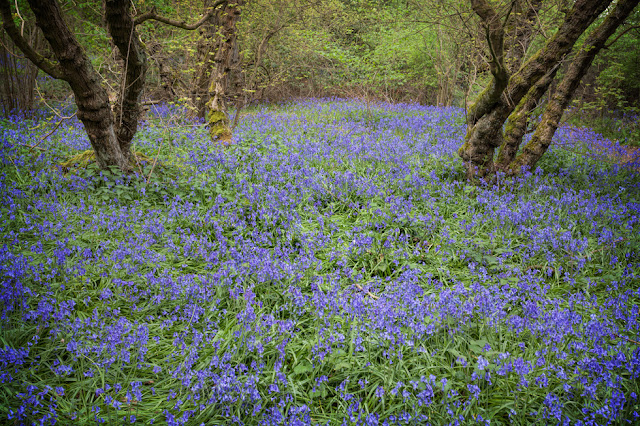Last week I took a trip to Brampton Wood, in search of bluebells, in fact I took two trips as it's a fairly large wood, and I couldn't do it justice in just one visit. In fact two trips barely grazes the surface of this fascinating place, but as it was the bluebell display I was after, that would just have to do, for now.
Brampton Wood, at 326 acres, is the second largest ancient woodland in Cambridgeshire, and is at least 900 years old. The first records date back to the Doomsday Book, “woodland pasture - half a league long and 2 furlongs wide”, when animals such as pigs used to feed on acorns. A large earth bank marks its ancient boundary, the bank and ditch barrier were built in the Middle Ages, to protect the wood from invading cattle and to keep pasture animals inside. There are several other minor banks and ditches within the wood, thought to be prehistoric field drainage systems.
 |
| When I first entered the woodland, it looked there had been a recent snowfall. These are seeds that have been blown down from trees ( I don't know what sort) and covered the floor all around. |
 |
| I liked the contrast between the fresh green leaves and the ivory carpeted ground. |
 |
| The wood is home to around 340 plant and 500 fungi species, including of course, a healthy population of bluebells in spring. |
The trees are mostly oak, ash and field maple, and in the past the wood has been used for hazel poles, timber, and hay as well as oak bark for tanning. Virtually the entire wood was clear felled, probably during the First World War, and has since regenerated naturally by growth from old stumps and seeds. The site’s national importance was recognised in 1954 when it was declared a Site of Special Scientific Interest.
 |
| New spring canopy above an indigo carpet. |
 |
| Can't get enough of these colours. |
 |
| As I was walking around the perimeter of the woods I spotted this golden rape field, so I squeezed through a gap to get a photo. |
 |
| A bit of sunshine lights up the jewelled ground. |
There are over one and a half miles of woodland rides here, some are at least 200 years old. The creation of rides and glades mimic natural processes of fires and storms (such as the 1987 hurricane) which open up expanses of woodland to sunlight, allowing ground flora to flourish, taller grassland areas to thrive, and fallen trees to rot down. Thanks to this management, the wood has thriving colonies of black hairstreaks, one of Britain’s rarest butterflies. Brown argus, white admiral and purple hairstreak can also be spotted.
 |
| A dense crop of flowers. |
 |
| These gnarled old trees sit on top of an enormous badger sett, constructed over many years by opportunist badgers in a World War 1 shooting practice mound. |
 |
| One of the many entrances to the sett. |
As I was blundering around getting some shots, I obviously disturbed the inhabitants, and a young badger poked his head up to see what all the noise was about. He wasn't around long enough for me to get a shot, but it was the first live badger I'd ever seen, so I was pretty chuffed, even though it was just a fleeting acquaintance.
 |
| A white bell conspicuous amongst all the blue. |
 |
| I love the vibrant colours this time of year. |
 |
| A view from the perspective of the woodland inhabitants. |
 |
| A jumble of greens and blues stretching into the distance. |
 |
| One of the many little paths that traverse the wood. |
 |
| Squashed bluebells. |
Unfortunately some areas had been trampled down, whether by people of dogs it was hard to say, although I did see quite a few 'paths' obviously made by people, leaving a trail of crushed flowers. Which is a shame, and unnecessary, as bluebells are very sensitive to disturbance, and take several years to recover once they have been damaged.
 |
| While it's nice to have some sun on the flowers, their colour really pops when they are in shade. |
 |
| On the way out I took the opportunity to get a couple of shots of these huge wind turbines in a rape field. |
 |
| The stormy clouds and late afternoon sunshine seemed to work well with these impressive structures. |

I have been reliably informed by Wildlife Trust Warden Tim Fryer, that the seeds are from Aspens (Populus tremula), in fact, there are more this year than anyone can remember.
ReplyDelete